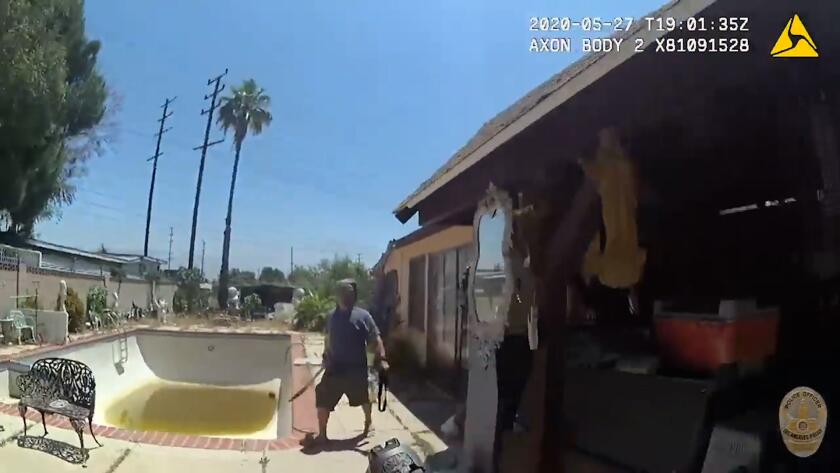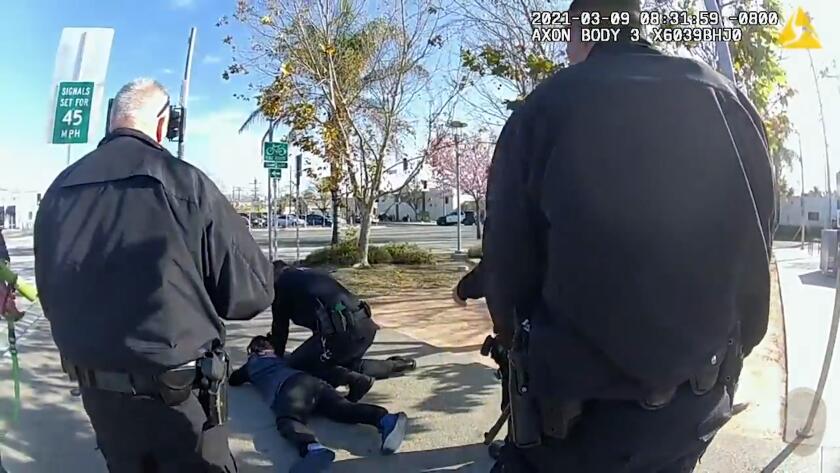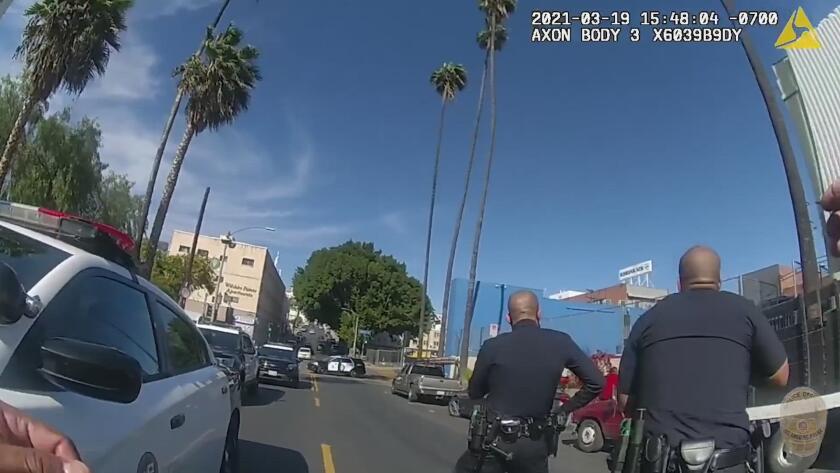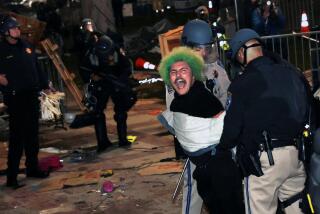LAPD shootings of unstable people wielding sharp objects a deadly problem
On May 27, 2020, an LAPD officer fatally shot Rommel Mendoza, 50, who was 77 feet away and waving a sword.
- Share via
On a North Hollywood street last year, Los Angeles Police Officer Daniel Harty watched through his rifle scope as 50-year-old Rommel Mendoza walked “erratically” toward him and a line of other officers, waving a sword and holding the lid of a cooking pan like a shield.
Mendoza, who lived on the block, seemed confused after being confronted at home by two officers investigating a report that he had hit a neighbor’s car with a stick. Mendoza’s family said he was sobbing, screaming, muttering incoherently and clearly needed help.
Again and again as Mendoza slowly advanced, Harty lifted his gaze to a white SUV parked between them, which he guessed was 20 to 30 feet away, he said. His LAPD training taught him that such distances could be closed by suspects with “edged weapons” such as knives or swords in a matter of seconds, putting officers in imminent danger, Harty said.
When Mendoza got to the SUV, Harty fatally shot him in the chest.
“I believe that if I didn’t press the trigger, he would have continued to close that distance,” Harty told investigators of the May 2020 shooting. “A lot of people don’t ... appreciate the fact that our bulletproof vests don’t stop swords.”
While LAPD shootings have dramatically declined in recent decades, scrutiny has grown in recent months around shootings like Mendoza’s, where mentally ill, intoxicated or homeless people are shot by police while armed not with firearms but with knives, swords, heavy tools or other blunt objects.
Police officials and officers like Harty say such weapons represent real, imminent threats. Others claim the danger is exaggerated and that officers are too quick to pull the trigger — another reason, amid the broader “defund the police” movement, they want mental health clinicians to take over calls from cops.
LAPD data reviewed by The Times show suspects were allegedly armed with “edged weapons” in about 18% of police shootings between 2015 and 2019, and with “impact devices” like bats in 4%. In 2020, edged weapons were identified in 23% of cases.
Of all people LAPD officers shot from 2016 to 2019, nearly a quarter were perceived to be suffering from a mental illness, while more than 80% were believed to be under the influence of drugs or alcohol, according to LAPD data.
Some of those encounters involved suspects shot as they attacked others, and body-worn video shows officers acting quickly to save people’s lives. In one incident in March, officers shot a man with a knife as he attacked the manager of his transitional housing unit.
Still, problematic shootings — where investigators have found officers made tactical errors and violated policies intended to reduce shootings — have also occurred, driven in part by unpredictable and fast-moving incidents and officers perceiving threats as being more imminent than they were.
Such shootings have continued despite increased efforts within the LAPD and across American policing to better de-escalate such encounters. Longstanding policies like the once-common “21-foot rule,” which held that anyone with a weapon within that distance represented an imminent threat, have increasingly been dropped in favor of more nuanced rules that prioritize de-escalation techniques and the use of “less lethal” alternatives to deadly force.
Charles Ramsey, a policing consultant and former chief in Washington, D.C., and Philadelphia, said departments across the country are increasingly looking “at every single manner in which training could improve” the way officers respond to people with such weapons.
“Whether you find out later that a person is schizophrenic, or you just find out that they are pissed off or angry, or have anger management problems, it doesn’t matter,” Ramsey said. “You still want to resolve it with the least amount of force as possible.”
At the same time, members of the public need to withhold judgment in such shootings until all the facts come to light, Ramsey said, because they are “very complicated” and extremely difficult for officers to navigate.
“You’re not always going to get it right,” he said.
Some encounters have sparked ongoing protests, including that of Daniel Hernandez, a 38-year-old man who appeared to be in the throes of a mental crisis when, after a traffic accident, he moved with a box cutter toward an officer who had just arrived on scene.
LAPD Officer Toni McBride, an ace-shooting social media influencer and daughter of an influential police union leader, called out for a “less lethal” projectile launcher, to no avail, then shot Hernandez six times in a matter of seconds, killing him.
LAPD Chief Michel Moore said the shooting was justified, but the civilian Police Commission disagreed on the final two shots, ruling that McBride should have reassessed the threat that Hernandez posed to her between rounds and stopped shooting after the fourth shot.
Other shootings, like Mendoza’s the next month, have garnered far less attention even when they raise similar questions about police tactics.
Police video showed Mendoza was shot as he walked down the middle of his street toward a large group of LAPD officers and supervisors who had lined up behind patrol vehicles for cover and who had various weapons — including at least one hard-foam projectile launcher — trained on Mendoza.
While Harty estimated Mendoza was 20 to 30 feet away when he shot him, investigators determined Mendoza was 77 feet away.
Although Harty said he believed his instructions from senior officers that day were to shoot Mendoza if he reached the white SUV — which he referred to as an agreed-upon “threshold” — others on the line believed the SUV was the point at which Mendoza should be shot with a projectile, not a rifle round.
The shooting devastated Mendoza’s large family, who said he was a kind and striving young man who had supported his immigrant family for years until mental illness and the pandemic knocked him off his path. They said he needed help from police that day, not a bullet.
“They took the life of a person who had a beautiful heart, a person who just needed help,” Mendoza’s older sister, Yvonne Mendoza, told the Police Commission in April. “So we are asking, why do you have to kill him?”
The commission’s answer, returned in a unanimous 4-0 vote, was that Harty did not have to kill Mendoza — at least not when he did.
The commission concurred with Moore and an internal review board in ruling that Harty had broken policy with his fatal shot.
It also agreed with Moore in disapproving of the actions of a sergeant helping to supervise the scene, who Moore wrote was “deficient in providing clear and concise instructions” on the force he wanted to be used when Mendoza reached the SUV.
Harty could not be reached for comment, and his attorney did not respond to requests for comment.
Mendoza’s family told the commission that justice wasn’t done that day.
Yvonne Mendoza said her brother immigrated to the United States at an early age and worked hard for years to provide for his family and others in his hometown in the Philippines, where he helped build a church, paid people’s hospital bills and was always the first to donate when natural disasters struck.
His younger brother, Raymund, said his brother was in crisis and police botched their response.
“If a person is having a problem, this person needs to be helped, not to be killed,” he said.
The family’s comments echoed those of protesters and activists in other cases. They and the family members of those killed have wondered why officers don’t use shields more often in such cases, and why they never seem to shoot people in the legs or arms, to stop them from advancing, instead of the upper torso, which kills them.
Some officials have asked similar questions, and say they are listening to the public’s outcry for more mental health clinicians to respond to people in crises rather than armed officers. The LAPD has launched a pilot program to divert calls around suicidal ideation to health workers, and county supervisors have launched new rapid-response mental health teams.
Still, police officials say that armed officers will continue to respond to encounters where people are armed. They also say that when shootings do occur, they are investigated thoroughly so that officers and the department can identify and learn from their mistakes.
The department’s use-of-force policy calls on officers to de-escalate situations first, to use verbal warnings, to use physical force only in proportion to the threat they are facing, and to open fire on suspects only when it is objectively reasonable to do so.
Officers receive training on how to respond to different threats, including going through simulators that force them to make split-second decisions in the face of virtual, armed suspects. Harty referenced going through such training, including for individuals with edged weapons, when speaking to investigators about shooting Mendoza.
A LAPD training bulletin from 2017 says the department’s goal was to resolve such incidents “with the least force possible.”
The bulletin says “distance is not the only factor that must be considered.”
It tells officers to also consider “danger signs” like people “talking to themselves,” to seek cover and to use whatever time they have to “establish control” through verbal appeals. It says physical force “must be appropriate for the actions displayed by the suspect.”
Additional policies pertaining to suspects with edged weapons implemented in 2016 require dispatchers to send a supervisor and an officer with a projectile launcher to every call for a person with an edged weapon.
During a discussion about police shootings during the Police Commission’s virtual meeting Tuesday, LAPD Deputy Chief Dominic Choi said the LAPD has made great strides in training officers on responding to mentally ill people and others with edged weapons, teaching them to use the formula “Cover + Distance = Time” to assess their surroundings and de-escalate situations whenever possible.
In some recent encounters, body-worn video shows LAPD officers doing just that.
In one incident in Topanga in March, officers found a man armed with a machete and claiming he was from another galaxy outside a Metro station. Video showed officers keep their distance as one speaks calmly to the man in Spanish, asking him to drop the weapon.
On March 9, LAPD officers took a man armed with a machete into custody after hitting him three times with projectiles. The man surrendered without further incident.
After several warnings, they shoot the man with projectiles as he begins to walk toward traffic, and he drops the machete and surrenders. Officials hailed it as a success.
Ten days later, officers confronted another man with a hammer in Westlake, with very different results.
Police believed the man, later identified as Samuel Ponce, was mentally ill or intoxicated. As he walked away from them, they repeatedly called out for him to drop the hammer. They also shot him multiple times with projectiles as he appeared to beg God for help.
Samuel Ponce was fatally shot after hurling an object at officers that turned out to be a bicycle part. Earlier in the encounter, Ponce was shot with projectiles multiple times without effect.
After trailing Ponce for blocks, a supervisor told the officers to “flank” Ponce. As they rushed in, he threw the hammer and then lifted a second object — which looked like an ax, but turned out to be a bicycle part — as one of the officers fatally shot him.
Activists denounced the shooting as unnecessary, blaming the officers for rushing Ponce in a threatening way when he was already in crisis and posed no immediate threat. The department is still investigating the shooting.
Internal discipline that is meted out in such cases, if any, is rarely made public, a reality that obscures whether and how the LAPD holds officers accountable when they break policy in shootings. Criminal prosecution of officers in such cases is extremely rare.
For Mendoza’s family, that system has allowed fatal police shootings to continue — a point they argue in a federal civil rights lawsuit filed this month.
In the lawsuit, the family calls Mendoza’s shooting “unreasonable, unnecessary, and cruel,” and allege L.A. officials have long ignored a “propensity” among LAPD officers to “callously and recklessly use excessive force” against residents.
Christopher Bou Saeed, the family’s attorney, said Mendoza’s death is a perfect example of that.
“You don’t have to be a lawyer,” he said, “to know that shooting someone exhibiting signs of mental illness from over 75 feet away doesn’t make any sense.”
More to Read
Sign up for Essential California
The most important California stories and recommendations in your inbox every morning.
You may occasionally receive promotional content from the Los Angeles Times.













